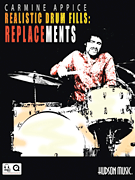REALISTIC DRUM FILLS: REPLACEMENTS
Carmine Appice

Cat #: HL-321208
Retail Price: $15.95
Our Price: $14.36
This item usually ships within 5 to 7 business days.
Questions?
Please call +1-518-587-1102 or email us.
Edition: Paperback Book & Online Audio, Drums
Description: 80 Pages
"I am really excited about this book," says Carmine, "I have had some students going through it already, and they love it - and it works!"
In this book/online audio package, rock drum legend Carmine Appice shows you how to play exciting and powerful drum fills like the pros, using a systematic method of replacing certain notes in the 16th or triplet flow with bass drum strokes. By using this book, drummers can learn how to incorporate the bass drums into their fills, thereby creating a complete professional vocabulary of cool, effective ideas to use in rock and other styles.
Using the same award-winning approach and notation method as Realistic Rock, the patterns contained in the book start with 8th notes and progress to 16th notes and triplets, with the rhythms split between the hands and feet. The fills are then expanded to include mixed stickings and accents, and are orchestrated around the kit.
The online audio contains audio examples of many of the patterns in the book, as well as video footage of Carmine in live performance, showing how he applies these concepts.
From the Introduction:
This book will develop your ability to play cool drum fills and solo ideas. I call this technique replacements. I’ve been using these concepts for many years and have seen many of my idols using them before me. Greats like Buddy Rich, Gene Krupa, Max Roach, Louis Bellson, and Billy Cobham (as well as many modern players) all use these kinds of replacements in their playing.
This book puts these concepts into a learning program that keeps progressing to the next (more difficult) level. We will move from eighth notes to triplets and sixteenths, which gets you playing different pulsations of these concepts. Once you understand the idea of what is happening with these, then you’ll see that you can use them in any playing situation. (That’s playing in a band!)




